| Listing 1 - 10 of 15 | << page >> |
Sort by
|
Book
Year: 1962 Publisher: Copenhagen : Danish Science Press,
Abstract | Keywords | Export | Availability | Bookmark
 Loading...
Loading...Choose an application
- Reference Manager
- EndNote
- RefWorks (Direct export to RefWorks)
Amoeba. --- Pinocytosis.
Book
ISBN: 9535127276 9535127268 953514152X Year: 2016 Publisher: IntechOpen
Abstract | Keywords | Export | Availability | Bookmark
 Loading...
Loading...Choose an application
- Reference Manager
- EndNote
- RefWorks (Direct export to RefWorks)
Autophagy in Current Trends in Cellular Physiology and Pathology is addressed to one of the fundamental molecular mechanisms - autophagy- evolutionarily adopted by cells for processing of unnecessary or malfunctioned constituents and shaping intracellular structures, adjusting them to environmental conditions, aging, disease, neoplasia, and damages over their life period. Particular attention is paid to autophagy-mediated barrier processes of selective sequestration and recycling of impaired organelles and degradation of invading microorganisms, that is, the processes sustaining intrinsic resistance to stress, tissue degeneration, toxic exposures, and infections. The presented topics encompass personal experience and visions of the chapter contributors and the editors; the book chapters include a broad analysis of literature on biology of autophagy.
Phagocytosis. --- Cytology. --- Autophagy. --- Cell biology --- Cellular biology --- Biology --- Cells --- Antigen-antibody reactions --- Endocytosis --- Immune response --- Immunology --- Phagosomes --- Pinocytosis --- Reticulo-endothelial system --- Tuftsin --- Autophagic vacuoles. --- Autophagocytosis --- Life Sciences --- Microbiology --- Genetics and Molecular Biology --- Cytology --- Biochemistry
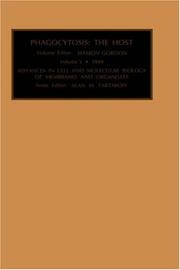
ISBN: 1281071838 9786611071837 0080526101 1559389990 9781559389990 9780080526102 9781281071835 6611071830 Year: 1999 Publisher: Stamford, Conn. JAI Press
Abstract | Keywords | Export | Availability | Bookmark
 Loading...
Loading...Choose an application
- Reference Manager
- EndNote
- RefWorks (Direct export to RefWorks)
An accompanying volume (Volume 6) in this series presents strategies of cellular invasion from the viewpoint of the microbe. This filed of study is growing rapidly after a somewhat slow start over recent decades. This collection of invited chapters attempts to reflect current research, and brings together cell biologists, microbiologists and immunologists with disparate interests. However, there is a certain unity, even repetition of key themes, hopefully like a symphony rather than a boring catalogue. It will be evident that editorial bias favors intracellular paratism and medically impor
Phagocytosis. --- Phagocytes. --- Macrophages. --- Histiocytes --- Mononuclear phagocytes --- Antigen presenting cells --- Connective tissue cells --- Killer cells --- Phagocytes --- Reticulo-endothelial system --- Cells --- Immune system --- Antigen-antibody reactions --- Endocytosis --- Immune response --- Immunology --- Phagosomes --- Pinocytosis --- Tuftsin
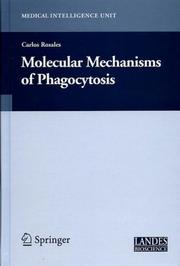
ISBN: 1281309842 9786611309848 0387286691 1423724070 0387254196 1489997636 Year: 2005 Publisher: New York, NY : Springer US : Imprint: Springer,
Abstract | Keywords | Export | Availability | Bookmark
 Loading...
Loading...Choose an application
- Reference Manager
- EndNote
- RefWorks (Direct export to RefWorks)
Although, Phagocytosis was first described nearly 120 year ago, we are just recently beginning to understand the molecules that phagocytic cells use to bring about this complex cell function. Molecular Mechanisms of Phagocytosis was prepared as a series of up-to-date essays (chapters) that describe the present knowledge on the various steps of the phagocytic process from initial cell contact, through internalization of the foreign particle, to the final phagosome formation where the phagocytosed particle is destroyed.
Phagocytosis. --- Antigen-antibody reactions --- Endocytosis --- Immune response --- Immunology --- Phagosomes --- Pinocytosis --- Reticulo-endothelial system --- Tuftsin --- Cytology. --- Oncology. --- Immunology. --- Biochemistry. --- Microbiology. --- Cell Biology. --- Cancer Research. --- Biochemistry, general. --- Microbial biology --- Biology --- Microorganisms --- Biological chemistry --- Chemical composition of organisms --- Organisms --- Physiological chemistry --- Chemistry --- Medical sciences --- Immunobiology --- Life sciences --- Serology --- Tumors --- Cell biology --- Cellular biology --- Cells --- Cytologists --- Composition --- Cell biology. --- Cancer research. --- Cancer research
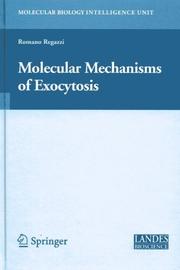
ISBN: 1281512931 9786611512934 0387399615 0387399607 Year: 2007 Publisher: New York, NY : Springer New York : Imprint: Springer,
Abstract | Keywords | Export | Availability | Bookmark
 Loading...
Loading...Choose an application
- Reference Manager
- EndNote
- RefWorks (Direct export to RefWorks)
Exocytosis is a fundamental cellular process that is used by eukaryotic cells to release a variety of biological compounds including peptide hormones and neurotransmitters or to insert specific lipids and proteins in the plasma membrane. In recent years, a multidisciplinary approach promoted an extraordinary progress in the understanding of the molecular mechanisms regulating exocytosis. This led to the discovery of a large number of components belonging to the machinery that governs the fusion of secretory vesicles with plasma membranes in different cell systems, including neuronal and endocrine cells. The basic machinery required for vesicle fusion turned out to be well conserved through evolution from yeast to man. So far, because of the large number of components involved, understanding of the molecular basis of exocytosis has remained the privilege of a relatively small group of specialists. This book, written by recognized experts in the field aims at clarifying for a non-specialist audience the role of the key players in the exocytotic process not only in neuronal and endocrine cells but also in a variety of other relevant cell systems. The book represents a unique collection of up-to-date reviews that will introduce researchers and students to the forefront of this rapidly moving and fascinating field.
Exocytosis. --- Cellular signal transduction. --- Cellular information transduction --- Information transduction, Cellular --- Signal transduction, Cellular --- Bioenergetics --- Cellular control mechanisms --- Information theory in biology --- Reverse pinocytosis --- Cell physiology --- Cytology. --- Neurobiology. --- Neurosciences. --- Cell Biology. --- Neurosciences --- Cell biology --- Cellular biology --- Biology --- Cells --- Cytologists --- Neural sciences --- Neurological sciences --- Neuroscience --- Medical sciences --- Nervous system --- Cell biology.
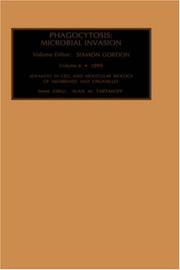
ISBN: 1281060135 9786611060138 008052608X 0762306106 9780762306107 9780080526089 9781281060136 6611060138 Year: 1999 Publisher: Stamford, Conn. JAI Press
Abstract | Keywords | Export | Availability | Bookmark
 Loading...
Loading...Choose an application
- Reference Manager
- EndNote
- RefWorks (Direct export to RefWorks)
The present volume focuses on microbial invasion strategies of pathogen uptake. An accompanying volume (Vol. 5) in the series presents the phagocytic process from the viewpoint of the host cell. This field of study is growing rapidly after a somewhat slow start over recent decades. This collection of invited chapters attempts to reflect current research and brings together cell biologists, microbiologists, and immunologists with disthemes, hopefully like a symphony rather than a boring catalogue. It will be evident that editorial bias favors intracellular parasitism and medically important
Phagocytosis. --- Phagocytes. --- Macrophages. --- Microbial invasiveness. --- Invasion, Microbial --- Invasiveness, Microbial --- Microbial invasion --- Microorganisms --- Virulence (Microbiology) --- Histiocytes --- Mononuclear phagocytes --- Antigen presenting cells --- Connective tissue cells --- Killer cells --- Phagocytes --- Reticulo-endothelial system --- Cells --- Immune system --- Antigen-antibody reactions --- Endocytosis --- Immune response --- Immunology --- Phagosomes --- Pinocytosis --- Tuftsin --- Invasion --- Invasiveness
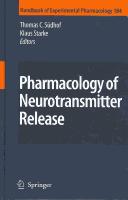
ISSN: 01712004 ISBN: 1281138029 9786611138028 3540748059 3540748040 3642094244 Year: 2008 Volume: v. 184 Publisher: Berlin : Springer,
Abstract | Keywords | Export | Availability | Bookmark
 Loading...
Loading...Choose an application
- Reference Manager
- EndNote
- RefWorks (Direct export to RefWorks)
It has been known for half a century that neurotransmitters are released in preformed quanta, that the quanta represent transmitter-storing vesicles, and that release occurs by exocytosis. The focus of this book is twofold. In the first part, the molecular events of exocytosis are analysed. This includes a discussion of presynaptic calcium channels, the core proteins of the secretory machinery, and the actions of clostridial toxins and a -latrotoxin, famous for their potency as well as their crucial role in the elucidation of the steps of exocytosis. In the book’s second part, the presynaptic receptors for endogenous chemical signals are presented that make neurotransmitter release a highly regulated process. These include ligand-gated ion channels and presynaptic G-protein-coupled receptors. The targets of presynaptic receptors within the exocytosis cascade, and their therapeutic potential, are subjects addressed in the majority of chapters.
Exocytosis. --- Neurotransmitter receptors. --- Neurotransmitters. --- Chemical nerve transmitters --- Nerve transmitter substances --- Neural transmitters --- Neurohumors --- Neuroregulators --- Synaptic transmitters --- Transmitters, Chemical nerve --- Transmitters, Synaptic --- Neurochemistry --- Neural transmission --- Receptors, Neurotransmitter --- Cell receptors --- Hormone receptors --- Neural receptors --- Reverse pinocytosis --- Cell physiology --- Toxicology. --- Neurosciences. --- Neurology. --- Human physiology. --- Pharmacology/Toxicology. --- Human Physiology. --- Human biology --- Medical sciences --- Physiology --- Human body --- Medicine --- Nervous system --- Neuropsychiatry --- Neural sciences --- Neurological sciences --- Neuroscience --- Chemicals --- Pharmacology --- Poisoning --- Poisons --- Diseases --- Toxicology --- Pharmacology. --- Neurology . --- Drug effects --- Medical pharmacology --- Chemotherapy --- Drugs --- Pharmacy --- Physiological effect
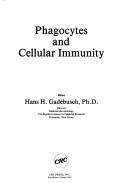
ISBN: 0849353491 9780849353499 Year: 1979 Publisher: Boca Raton, Fla
Abstract | Keywords | Export | Availability | Bookmark
 Loading...
Loading...Choose an application
- Reference Manager
- EndNote
- RefWorks (Direct export to RefWorks)
Immunology. Immunopathology --- Immunity, Cellular --- Phagocytosis --- Cellular immunity --- Immunité cellulaire --- Phagocytose --- Cellular immunity. --- Phagocytosis. --- Phagocytoses --- Leukocytes --- Macrophages --- Opsonin Proteins --- Phagosomes --- Cellular Immune Response --- Cell-Mediated Immunity --- Cell Mediated Immunity --- Cell-Mediated Immunities --- Cellular Immune Responses --- Cellular Immunities --- Cellular Immunity --- Immune Response, Cellular --- Immune Responses, Cellular --- Immunities, Cell-Mediated --- Immunities, Cellular --- Immunity, Cell-Mediated --- Response, Cellular Immune --- Lymphokines --- T-Lymphocytes --- Interleukin-12 --- Antigen-antibody reactions --- Endocytosis --- Immune response --- Immunology --- Pinocytosis --- Reticulo-endothelial system --- Tuftsin --- Cell-mediated immunity --- Cellular immunology --- Clonal selection theory --- Immunity --- Immunité cellulaire --- Immunity, Cellular.
Book
ISBN: 9401782997 140209292X 9786612037993 1282037994 1402092938 Year: 2009 Publisher: [Dordrecht] : Springer,
Abstract | Keywords | Export | Availability | Bookmark
 Loading...
Loading...Choose an application
- Reference Manager
- EndNote
- RefWorks (Direct export to RefWorks)
Phagocytosis has been at the forefront of cell biology for more than a century. Initially, phagocytosis, which comes from Greek words meaning “devouring cells,” was discovered in the late 19th century by Ilya Metchnikoff, who was awarded, together with Paul Ehrlich, the Nobel Prize in Physiology and Medicine in 1908 “in recognition of their work on immunity.” At that time Metchnikoff had already identified a function for phagocytes not only in host defense but also as scavengers of degenerating host cells during metamorphosis of tadpoles, thus providing one of the first descriptions of apoptotic cell clearance by macrophages (Kaufmann 2008). Since then, much has been learned about phagocytosis, and the previous several decades have witnessed outstanding progress in understanding the functions and the molecular mechanisms of phagocytosis. Two main types of targets are cleared by phagocytosis: microbial pathogens and dying cells. Rapid recognition and clearance of dying cells by phagocytes plays a pivotal role in development, maintenance of tissue homeostasis, control of immune responses, and resolution of inflammation. Clearance of dying cells can be divided into several stages, including sensing, r- ognition, binding and signaling, internalization, and immunological responses. In this book, our contributors address these different stages of dead cell cle- ance and examine how impaired clearance of dying cells may lead to human d- eases. We have attempted to provide sufficient cross-referencing and indexing to enable the reader to easily locate the ideas elaborated in the different chapters.
Cytology. --- Immunology. --- Medicine. --- Oncology. --- Rheumatology. --- Phagocytosis --- Cell death --- Disease --- Physiology --- Cell Death --- Cell Physiological Processes --- Immune System Processes --- Endocytosis --- Biological Science Disciplines --- Blood Physiological Processes --- Immunity, Innate --- Pathologic Processes --- Immunity --- Natural Science Disciplines --- Immune System Phenomena --- Blood Physiological Phenomena --- Pathological Conditions, Signs and Symptoms --- Cell Physiological Phenomena --- Circulatory and Respiratory Physiological Phenomena --- Disciplines and Occupations --- Phenomena and Processes --- Diseases --- Microbiology & Immunology --- Biology --- Health & Biological Sciences --- Phagocytosis. --- Cell death. --- Cell degeneration --- Cancer research. --- Apoptosis. --- Biomedicine. --- Cancer Research. --- Cells --- Death (Biology) --- Antigen-antibody reactions --- Immune response --- Immunology --- Phagosomes --- Pinocytosis --- Reticulo-endothelial system --- Tuftsin --- Oncology . --- Internal medicine --- Connective tissues --- Joints --- Immunobiology --- Life sciences --- Serology --- Cell biology --- Cellular biology --- Cytologists --- Tumors --- Cancer research
Book
ISBN: 3642260373 364200301X 9786612509223 1282509225 3642003028 Year: 2009 Publisher: Berlin : Springer,
Abstract | Keywords | Export | Availability | Bookmark
 Loading...
Loading...Choose an application
- Reference Manager
- EndNote
- RefWorks (Direct export to RefWorks)
Autophagy is a fundamental biological process that enables cells to autodigest their own cytosol during starvation and other forms of stress. It has a growing spectrum of acknowledged roles in immunity, aging, development, neurodegeneration, and cancer biology. An immunological role of autophagy was first recognized with the discovery of autophagy’s ability to sanitize the cellular interior by killing intracellular microbes. Since then, the repertoire of autophagy’s roles in immunity has been vastly expanded to include a diverse but interconnected portfolio of regulatory and effector functions. Autophagy is an effector of Th1/Th2 polarization; it fuels MHC II presentation of cytosolic (self and microbial) antigens; it shapes central tolerance; it affects B and T cell homeostasis; it acts both as an effector and a regulator of Toll-like receptor and other innate immunity receptor signaling; and it may help ward off chronic inflammatory disease in humans. With such a multitude of innate and adaptive immunity functions, the study of autophagy in immunity is one of the most rapidly growing fields of contemporary immunological research. This book introduces the reader to the fundamentals of autophagy, guides a novice and the well-informed reader alike through different immunological aspects of autophagy as well as the countermeasures used by highly adapted pathogens to fight autophagy, and provides the expert with the latest, up-to-date information on the specifics of the leading edge of autophagy research in infection and immunity.
Autophagic vacuoles. --- Autophagy. --- Cellular immunity. --- Immunity, Innate. --- Infection -- immunology. --- Cellular immunity --- Autophagic vacuoles --- Infection --- Immunity, Innate --- Autophagy --- Immunity --- Bacterial Infections and Mycoses --- Cell Death --- Phagocytosis --- Immune System Phenomena --- Cell Physiological Processes --- Diseases --- Endocytosis --- Phenomena and Processes --- Cell Physiological Phenomena --- Microbiology & Immunology --- Biology --- Health & Biological Sciences --- Phagocytosis. --- Cell-mediated immunity --- Cellular immunology --- Medicine. --- Immunology. --- Medical microbiology. --- Virology. --- Biomedicine. --- Medical Microbiology. --- Microbiology --- Immunobiology --- Life sciences --- Serology --- Clinical sciences --- Medical profession --- Human biology --- Medical sciences --- Pathology --- Physicians --- Antigen-antibody reactions --- Immune response --- Immunology --- Phagosomes --- Pinocytosis --- Reticulo-endothelial system --- Tuftsin --- Clonal selection theory --- Medical virology. --- Microbiology. --- Microbial biology --- Microorganisms --- Medical microbiology --- Virology --- Virus diseases
| Listing 1 - 10 of 15 | << page >> |
Sort by
|

 Search
Search Feedback
Feedback About UniCat
About UniCat  Help
Help News
News